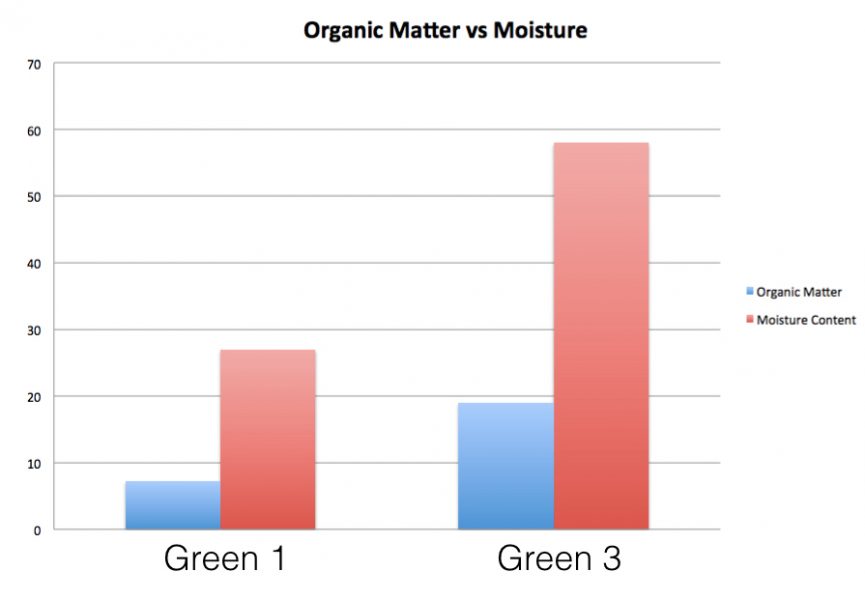Last time I revealed the results from an experiment I did to establish the percentage of Organic Matter (OM) in 3 very different greens. My hypothesis says that there is a link between Soil Moisture and Bowls Green Performance. To recap, one of these greens was a natural seaside links type green with a good homogenous sandy loam all the way down the profile with no layering and just a little thatch near the surface.
The second green was a 20 year old green that was built to USGA specification using a quarry sand and local sandy loam topsoil. This green, although boasting a nice homogenous rootzone mix, was showing signs of excessive thatch (organic material) build up at the surface.
The third of our greens was a typical push up type green, simply made from local (quite heavy) soil and suffering as a result of that and decades of inappropriate maintenance and now showing a high percentage of Organic Material, much of which was probably mat and thatch at the surface and only partly decomposed Organic Matter in layers within the deeper profile.
By homogenous, I mean that the soil is a well mixed combination of Mineral Material and Organic Matter throughout the depth of the soil profile. There are no distinct layers in the soil profile, it is a completely mixed material and it isn’t possible to distinguish between the Organic and Mineral components by sight alone. To achieve this, the Organic Matter has been completely decomposed by the soil micro-organisms into a state known as Humus. This material is a critical component of a healthy, living bowls green as it provides a mechanism for moisture and nutrient retention in the soil.
Firmness
Prior to doing what is termed the Loss on Ignition test to ascertain the Organic Matter content of these 3 soil samples we had also undertaken firmness tests with the Clegg Hammer and these showed that the greens that were higher in Organic Matter content, were less firm and so less likely to provide a true and smooth bowling surface.
You might remember what the graph looked like of Firmness against Moisture content from my earlier article. Here it is again:

You can see from the chart above that there is a very clear correlation between moisture content and firmness. When moisture goes up, firmness (and of course smoothness/trueness) reduces.
So far I’m not revealing anything you don’t instinctively know, but let us now look at Moisture content plotted against Organic Matter content. This time I only have the data for the Links green (no.1) and the push up green (No.3):

Now the correlation is very clear and our hypothesis is proved to be correct. You might recall that the full hypothesis was as follows:
- Bowling Green Surface Trueness and Smoothness are correlated with green surface firmness (firmer greens are smoother and truer).
- Bowling Green surface firmness is correlated with soil moisture content (wetter greens are less firm).
- Soil Moisture Content is correlated with Soil Organic Matter Content
- Therefore the Performance of Bowling Green Surfaces is correlated with Soil Organic Matter Content.
The results clearly show that excessive Organic Matter in greens causes them to perform less well.
But, what is excessive in terms of Organic Matter?
Again, you might recall from earlier articles my Pie Chart of the perfect soil:

In the tests that I have done on golf and bowls greens and through the research I have carried out with my students the above diagram is found to be the ideal combination for the very highest levels of surface performance, in fact this would be to tournament standards.
An Organic Matter content of around 5% will typically yield a soil moisture content of between 20-30% of Field Capacity and this provides a firm surface that typically reads around 100-120 gravities on the Clegg Hammer.
Organic Matter in this case is Humus and there would only be the minimum of thatch (un-decomposed organic material) at the surface.
Scientists we are not!
I know what you’re thinking; it’s bad enough trying to get the mower set properly and find someone to cut the green with it every day without having to become a scientist and undertake experiments into the bargain!
Well I hope by going through this experimental process I have created a shortcut for you. Even if you wanted to get all scientific you could certainly short circuit this experiment by just jumping straight to the Loss on Ignition Test to ascertain Organic Matter content. We’ve already proved that it is Organic Matter that is the key to getting moisture levels and therefore firmness and therefore smoothness and trueness into order.
However, my real hope for this series of articles is that it will inspire you to trust your gut instincts about your green and to take soil profile samples regularly so that you can see what’s going on under your green and build up a deep understanding of it.
I haven’t told you anything you don’t already know:
- Wet greens are soft, uneven and slow.
- Thatchy greens are wet.
- Excessively sandy greens promote excessive thatch, dry patch and hardness rather than firmness
- Greens that come closest to the ideal soil piechart (50% space, 45% mineral and 5% OM) perform to a very high standard consistently.
Diluting Thatch.
Next time I’m going to dispel another great greenkeeping myth. Namely that the process of sand top-dressing dilutes thatch and somehow encourages the creation of homogenous soil. It doesn’t and I’ll explain why and more importantly I’ll explain the damage that it actually does which is totally contrary to the claims made for it.
Getting Ready for Opening Day
Next week I’ll also start a series of articles to help you get ready for opening day. Please feel free to drop me a line with any questions you have about this critical maintenance period.

